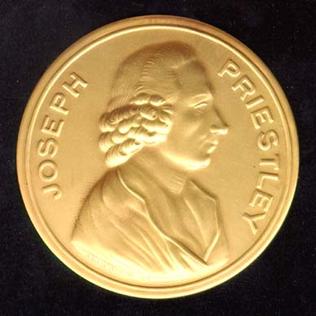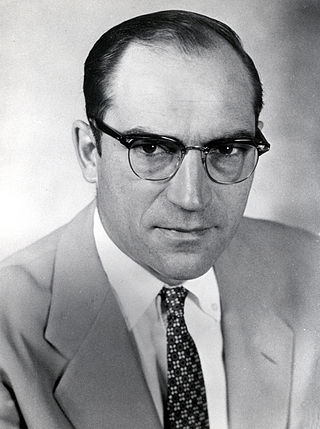
The Royal Society of Edinburgh (RSE) is Scotland's national academy of science and letters. It is a registered charity that operates on a wholly independent and non-partisan basis and provides public benefit throughout Scotland. It was established in 1783. As of 2021, there are around 1,800 Fellows.

The Priestley Medal is the highest honor conferred by the American Chemical Society (ACS) and is awarded for distinguished service in the field of chemistry. Established in 1922, the award is named after Joseph Priestley, the discoverer of oxygen who immigrated to the United States of America in 1794. The ACS formed in 1876, spearheaded by a group of chemists who had met two years previously in Priestley's home.
Robert Ferguson Legget was a civil engineer, historian and non-fiction writer. He is internationally known for his contributions to engineering, geology and building research and standardization. He is credited with the establishment of co-operation among Canadian geotechnical engineers, geologists and pedologists.

The Perkin Medal is an award given annually by the Society of Chemical Industry to a scientist residing in America for an "innovation in applied chemistry resulting in outstanding commercial development." It is considered the highest honor given in the US chemical industry.

Luna Bergere Leopold was a leading U.S. geomorphologist and hydrologist, and son of Aldo Leopold. He received a B.S. in civil engineering from the University of Wisconsin in 1936; an M.S. in physics-meteorology from the University of California, Los Angeles in 1944; and a Ph.D. in geology from Harvard University in 1950.

Rafael Luis Bras is a Puerto Rican civil engineer best known for his contributions in surface hydrology and hydrometeorology, including his work in soil-vegetation-atmosphere system modeling.

The Daniel Guggenheim Medal is an American engineering award, established by Daniel and Harry Guggenheim. The medal is considered to be one of the greatest honors that can be presented for a lifetime of work in aeronautics. Its first recipient was Orville Wright. Other recipients have included American and international individuals from aeronautical corporations, governments, and academia.
The Hoover Medal is an American engineering prize.
The ASA Silver Medal is an award presented by the Acoustical Society of America to individuals, without age limitation, for contributions to the advancement of science, engineering, or human welfare through the application of acoustic principles or through research accomplishments in acoustics. The medal is awarded in a number of categories depending on the technical committee responsible for making the nomination.
The IEEE Edison Medal is presented by the Institute of Electrical and Electronics Engineers (IEEE) "for a career of meritorious achievement in electrical science, electrical engineering, or the electrical arts." It is the oldest medal in this field of engineering. The award consists of a gold medal, bronze replica, small gold replica, certificate, and honorarium. The medal may only be awarded to a new leap/breakthrough in the technological area of science.

The IEEE Medal of Honor is the highest recognition of the Institute of Electrical and Electronics Engineers (IEEE). It has been awarded since 1917, when its first recipient was Major Edwin H. Armstrong. It is given for an exceptional contribution or an extraordinary career in the IEEE fields of interest. The award consists of a gold medal, bronze replica, certificate, and honorarium. The Medal of Honor may only be awarded to an individual.
The ASME Medal, created in 1920, is the highest award bestowed by the ASME Board of Governors for "eminently distinguished engineering achievement". The award has been presented every year since 1996, and it consists of a $15,000 honorarium, a certificate, a travel supplement not to exceed $750, and a gold medal inscribed with the words, "What is not yet, may be".
The John Wesley Powell Award is a United States Geological Survey (USGS) honor award that recognizes an individual or group, not employed by the U.S. federal government, for noteworthy contributions to the objectives and mission of the USGS.
The George Westinghouse Medal is named for George Westinghouse and awarded to in honor of "eminent achievement or distinguished service in the power field of mechanical engineering" by the American Society of Mechanical Engineers. There is a Gold medal and a Silver medal. The silver medal may only be awarded to someone under 45 years of age.
The John Fritz Medal has been awarded annually since 1902 by the American Association of Engineering Societies (AAES) for "outstanding scientific or industrial achievements". The medal was created for the 80th birthday of John Fritz, who lived between 1822 and 1913. When AAES was dissolved in 2020, the administration of the Fritz medal was transferred to the American Institute of Mining, Metallurgical, and Petroleum Engineers (AIME), and is currently coordinated by AIME member society, the Society of Mining, Metallurgy, & Exploration (SME).
SPIE Gold Medal, or Gold Medal Award of SPIE, is the highest honor of SPIE, and is considered one of the highest award in the fields of photonic and optical engineering and related instrumental sciences. The Gold Medal started awarding annually since 1977, and the award includes a medal and $10,000 cash award.
The Beilby Medal and Prize is awarded annually to a scientist or engineer for work that has exceptional practical significance in chemical engineering, applied materials science, energy efficiency or a related field. The prize is jointly administered by the Institute of Materials, Minerals and Mining, the Royal Society of Chemistry and the Society of Chemical Industry, who make the award in rotation.

William James Sutherland is the Miriam Rothschild Professor of Conservation Biology at the University of Cambridge. He has been the President of the British Ecological Society. He has been a Fellow of St Catharine's College, Cambridge since 2008.

Bruce E. Rittmann is Regents' Professor of Environmental Engineering and Director of the Swette Center for Environmental Biotechnology at the Biodesign Institute of Arizona State University. He was also elected a member of the National Academy of Engineering in 2004 for pioneering the development of biofilm fundamentals and contributing to their widespread use in the cleanup of contaminated waters, soils, and ecosystems.








